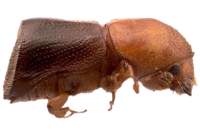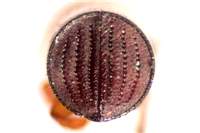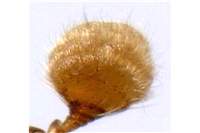Diagnosis
Main character: the elytral end is sharply truncated, surrounded by a perfectly circular elevated costa. There are no denticles on or around the declivity, except occasional tubercels on the interstria 1. Other important characters: antennal club of type 4 (with first segment reduced, second and third segment large, pubescent) or 5 (boundaries between segments obscured by pubescence or completely reduced).
Similar to Truncaudum, except the costa surrounding elytral declivity doesn't bear teeth, pronotum is short, pubescence rare or absent.
Some Xylosandrus also have truncated declivity, but their antennae are of type 1 or 2, and there is a distinct tuft of mycangial hair on the basis of pronotum.
Distribution
Relatively common in Asia and Australasia, rare in Africa, possibly one rare species in South America.
Biology
Most species create a short tunnel ending with a flat and often large brood cavity, longitudinal with wood fibers. Gallery entrance is guarded with the flat end of elytral declivity.
Taxonomy
Closely related to Truncaudum, several rare species have conflicting characters and may belong to either of the two genera (see Hulcr & Cognato 2010a).
Detailed description
Eyes deeply emarginate to almost disjunct, upper part of eye smaller than lower part. Antennal club circular, type four (segment 1 small, second and third prominent on both sides), or five (all pubescent, sutures obscured). Segment 1 of club convex, small, its margin segment soft and pubescent on posterior side, or margin all soft, pubescent. Segment 2 visible on both sides of club, but soft, or corneous part on anterior side only, rarely corneous on both sides of club. Segment 3 clearly visible and dominant on both sides of club. Segment 1 of antennal funicle shorter than pedicel, funicle 4-segmented, scapus of regular shape (relatively robust and curved, not long and slender). Mandibular mycangia may be visible as swellings above epistoma. Frons above epistoma mostly smooth or alutaceous, with minor punctures. Submentum deeply impressed, narrow (shaped as very narrow triangle). Anterior edge of pronotum mostly with distinct row of serrations. Pronotum from lateral view of basic shape (type 0), or elongated, with low summit (type 7), or with disc distinctly elongated (type 8). Pronotum from dorsal view basic, short, parallel-sided, rounded frontally (type 2), or elongated basic shape with rounded frontal margin (type 7). Pronotal disc shining or smoothly alutaceous, with small punctures, lateral edge of pronotum obliquely costate. Procoxae contiguous or narrowly separated, prosternal posterocoxal process short and conical, or flat and inconspicuous, or tall and pointed. No setose mycangial openings either in mesonotum or in elytral bases. Scutellum flat, flush with elytra. Elytral bases straight, with oblique edge, elytral disc longer than declivity, flat, punctures on elytral disc in strial lines. Elytral declivity sharply truncated, mostly with complete circumdeclivital costa or elevated carina around margin. Declivity mostly devoid of hair, of with few setae or scales, or covered with adherent flat setae or scales. Declivital surface variable but always devoid of major projections or other structures, except small uniform granules. First interstriae parallel on elytral disc, often distinctly broadened towards apex of elytra. Protibiae with evenly rounded edge to obliquely triangular, broadest at 2/3 of its length, to very slender, slightly broader only at distal end. Posterior side of protibia flat, without tubercles (setae only), or appears inflated, often with several granules. Protibial denticles small, bases of denticles not enlarged or only slightly elevated, usually between 6 and 8 protibial denticles. Metatibiae of regular size. Length: 2.1-3.7 mm. Color: uniformly light brown, or reddish, or uniformly dark brown, or rarely uniformly black, pronotum commonly lighter than elytra, sometimes starkly contrasting (yellow pronotum, black elytra).



